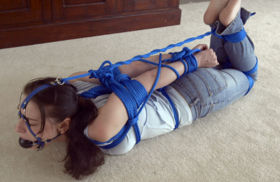Hogtie
(Placement of photo) |
m (→See also: Add x-ref) |
||
| Line 18: | Line 18: | ||
* [[Kneeling hogtie]] | * [[Kneeling hogtie]] | ||
* [[Pretzel hogtie]] | * [[Pretzel hogtie]] | ||
| + | * [[Spread hogtie]] | ||
* [[Straitjacket hogtie]] | * [[Straitjacket hogtie]] | ||
* [[Suspended hogtie]] | * [[Suspended hogtie]] | ||
Revision as of 06:06, 5 May 2009
Hogtying is a method of tying the limbs together, rendering the 'hogtied' victim immobile. Originally, it applied to pigs; now it can also be applied to human bondage (see also hogtie bondage) and a method for subduing individuals sometimes employed by the police.
The standard procedure on humans is to tie the victim's wrists together behind the back, tie the ankles together and join the wrist and ankle ties, forcing the legs to be bent double. Often, elbow bondage is used; the knees may also be tied together.
If the victim's arms are in a monoglove, a hogtie may be achieved by tying the ankles to the tip of the monoglove.
Usually, the wrists and ankles are brought into close proximity but not touching. In a more stringent hogtie, they are made to touch or even overlap. This usually causes the back to arch, and it may cause severe discomfort if the bondage is prolonged.

The "Italian rope trick"
A very nasty, and very lethal form of hogtie was and is used as a form of torture: The hands are tied behind the back and the feet are tied together, with one end of the rope around the victim's neck. The tension of the legs pulling on the neckrope can only be lifted for a limited period of time by using the muscles in the back, breast and belly. When those muscles get tired, the victim strangles him/herself. This is sometimes referred to as the "Italian rope trick" and has been used by the Mafia.

